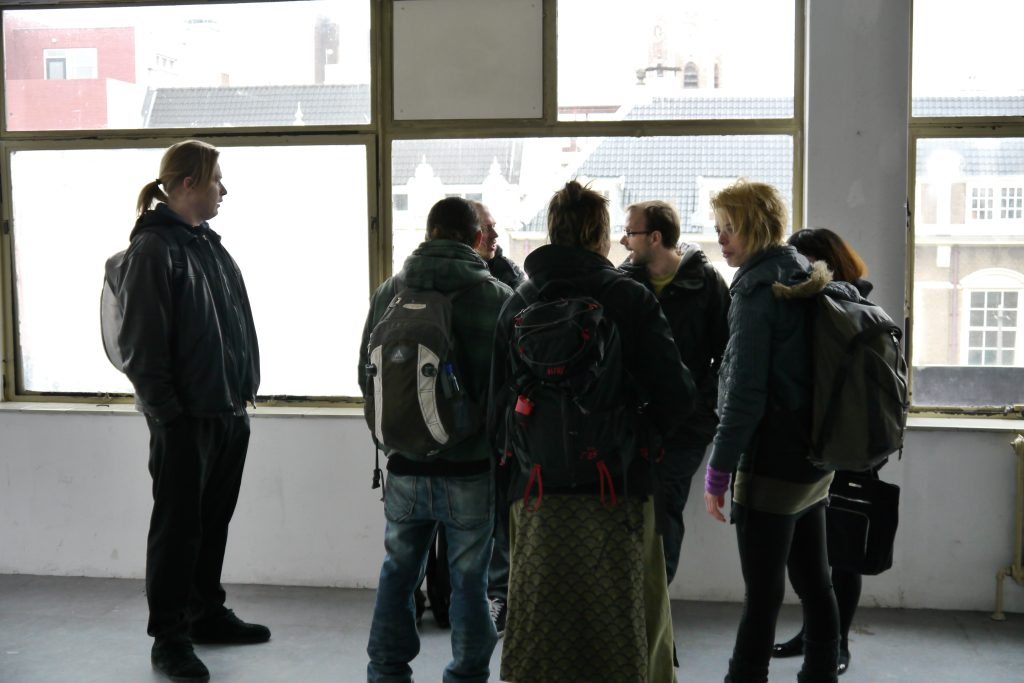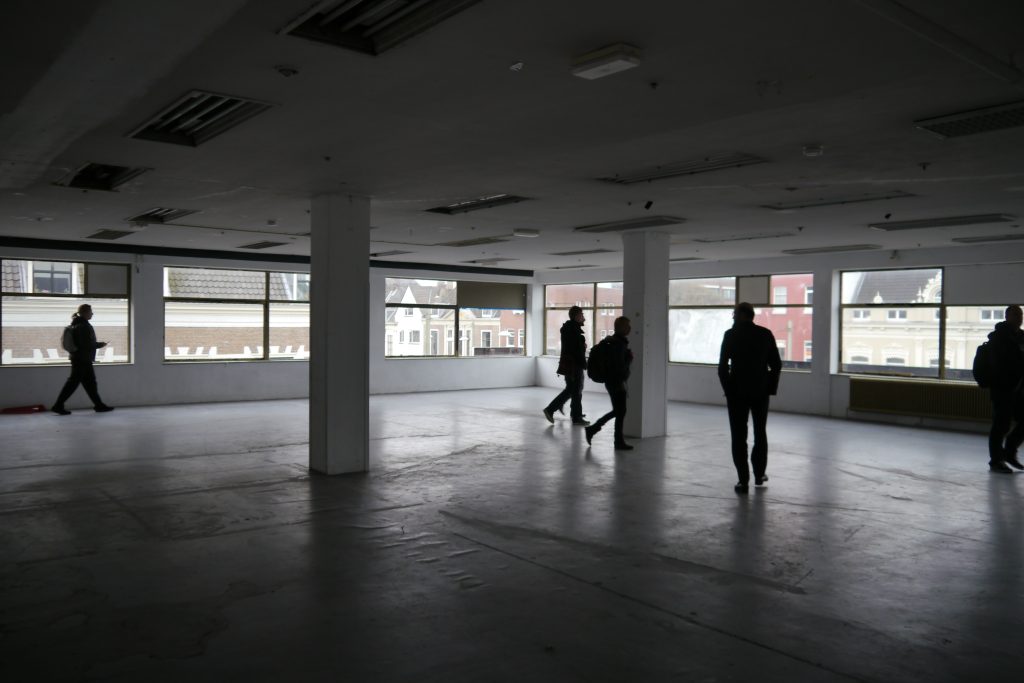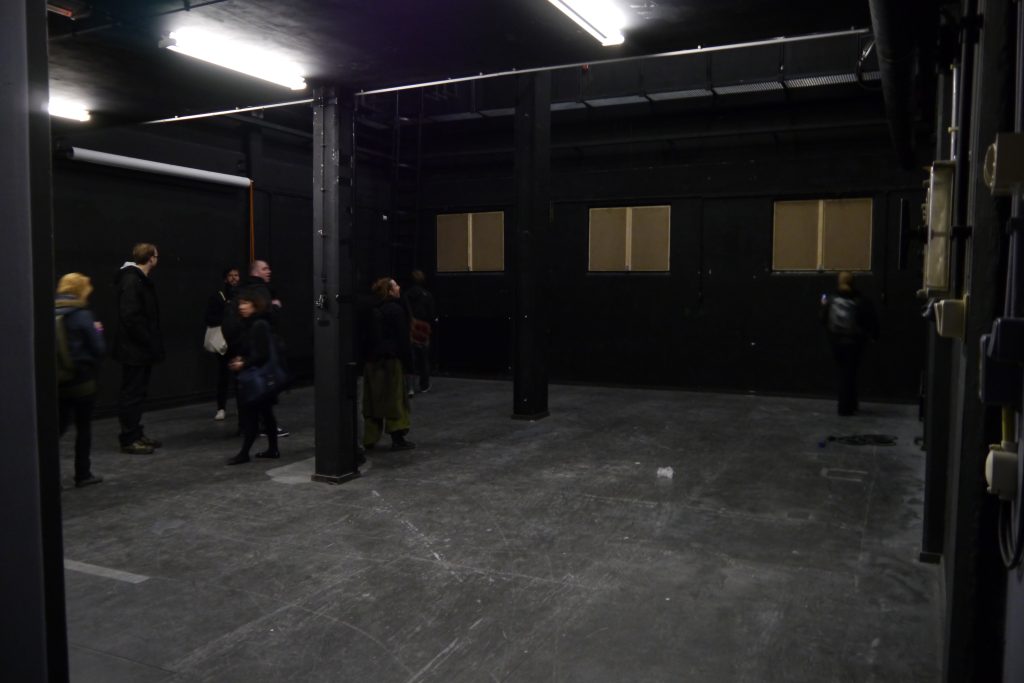Tracing iii’s roots
A story about Image and Sound, Evers & Raaijmakers and the Egyptian ‘Fantasia’.
(Michael van Hoogenhuyze)
‘Instrument Inventors Initiative’, better known as ‘iii’, is an organisation supporting new experimental art practices. This year, iii has turned ten years old. The initiative was started as an organisation by and for a group of artists themselves, doing the supporting activities for their work. iii still functions that way. In the meantime, iii has grown into a renowned art organisation, a development that was perhaps difficult to foresee back when the platform started in a room of an old office meant to be replaced by new architecture, very soon.
But where did iii come from? Which were its roots, and what do these tell about iii as an initiative?
iii’s fertile ground: Image and Sound
The fertile ground from which iii came to be, is preceded by what began inside the organisation of the Royal Academy and the Royal Conservatory in The Hague. Between the academy and the conservatory there was developed a unique cooperation, which was stimulated by the foundation of the Interfaculty for Image and Sound (founded in 1990), an experimental department where elements of both institutes were combined.
Along the way, the name has changed from ‘Interfaculty for Image and Sound’ to ‘ArtScience’. Academy and conservatory started to cooperate. ArtScience also had more contact with the university. The fact that the name changed to ArtScience, was a sign that it was open to cooperate in scientific experiments and scientific disciplines. This was a development which created a situation in which the emergence of an initiative like iii becomes more obvious. ArtScience had a special place in the conservatory and the academy. Technology and demonstrations of scientific experiments became an important element of the activities of the students, but mingled with more poetic approaches.

ArtScience students scouting for preview show, 2012
(Photos by Dieter Vandoren)
The first steps of iii: Setting up a foundation
Around the founding years of iii, there came to be a new way of organising the final examinations at the art academy: The graduating students were expected to organise a special exhibition presentation themselves in which they had to convey the methods and ideals in their work to an audience consisting of teachers, other students and public from outside.
Presentations are already complex to organise, but especially so for ArtScience students: Whilst some students need a completely dark place to be able to completely control the light, others need a light space for performance or for a complicated installation. Or for some, there is a need for absolute silence, whereas others need to be able to make a lot of (mostly) electronic sound. Thus, the final exam exhibition was a difficult project to organise, with a lot of problems and challenges. It made the final year for ArtScience students a heavy project. This had to take place around a month before the official final exams, which they would have after this exhibition, in the building of the academy.
To make the aforementioned exhibition possible, the students set up a foundation. With this foundation they could try to get monetary support for the project and get opportunities for extra facilities from the academy or the conservatory. This practice turned out to be successful: With the experience of setting up a foundation, there grew the idea to create a permanent platform for young starting artists in the field of experimental art, exhibitions, and experiments with new technology. And so iii came into being.

ArtScience students scouting for preview show, 2012
(Photos by Dieter Vandoren)
Artists of iii are special both because of the works they show as well as because of their activities. A lot of their projects are determined by the use of technology. It makes their work paradoxical: With technology we suppose there is a goal and there are means to reach said goal. We expect people are using efficient solutions in using machines and in handling facilities. But an installation following the methods of iii will have only the work itself as a goal, bringing attention to the way of working rather than to the result. For a lot of art works nowadays, especially for works of iii, the goal is not the purpose. An installation in art is a poetic construction to make a musical demonstration of an experiment possible. ‘Efficiency’ or ‘truth’ are not important in this case. At the same moment, the artist feels the urge to do things ‘this’ or ‘that’ way.
A step back…How Interfaculty for Image and Sound came to be
An important moment in the history of the field iii finds itself in, was the meeting between the sensory psychologist Frans Evers and the composer Dick Raaijmakers, both working at the Royal Conservatory in The Hague. Frans tried to find a way to continue the research he started in the US. But he didn’t get the response for the plans he set out for. Dick’s advice to Frans was to go on teaching, but in the conservatory there wasn’t any interest for research; only experiments in the field of teaching were considered interesting. Dick was looking for cooperation with which he could expand his ideas as a composer in the direction of music theatre and to activities connected to the art movement Fluxus. In such a cooperation Dick could start to do research in new art forms and Frans could teach in the field of synesthesia and start a new department that positions itself in between conservatory and academy. It was the start of “Interfaculty for Image and Sound”.
The two organised some spectacular projects for which they needed the help from all the teachers and students of the department. These projects were theatrical presentations and theoretical studies in the field of the European artists from the beginning of the 20th century: Kandinsky, Schönberg, Moholy Nagy, Mondriaan. For these projects each helping hand was essential. Cooperation became an important value in these years. But a lot of members of the department also got the opportunity to work on personal subjects and fascinations. Theatre productions directed by Paul Koek of “Theater Hollandia”, exhibitions and lectures in the “Gemeentemuseum/Kunstmuseum” in The Hague, made the school of Sound and Image a real adventure. Fluxus-like performances were combined with research about synesthesia. It all happened in a good atmosphere with open discussions, much speculation and new ideas.

ArtScience students scouting for preview show, 2012
(Photos by Dieter Vandoren)
(Frans Evers was in contact with the Italian musician and researcher Walter Majoli, a specialist in the field of prehistoric music. Walter was always eager to learn to know new sounds and music instruments. He collected old tools from prehistoric caves but also music instruments for children. All these tools and instruments he used for presentations about prehistoric music. One moment Walter said that all musical sounds of the 20th century already were made in prehistoric time, to which Dick Raaijmakers replied: “Maybe that is true, but we can make the sounds much louder!”. It is a story explaining well how Dick strongly believed in new technology.)
Another step back…Experiments in Eindhoven and Brussels
The cooperation between Frans Evers and Dick Raaijmakers resulted in the Interfaculty (later ArtScience, the starting point of iii). But there is also a longer story about activities in this field, functioning as the forerunners of the Interfaculty.
Experiments with electronic music and sound were done at an earlier stage, in the studio of Philips Radio in Eindhoven. Dick Raaijmakers was one of the researchers doing projects there. A famous result was a gramophone record named “Song of the Second Moon”. For this piece, Dick chose deliberately for an electronic version of popular music. It was the first electronic pop single. Dick was the composer, but used a pseudonym: “Kid Baltan”. It is the reversal of Dick Natlab, Dick’s nickname as a researcher in the laboratory of Philips (coming from ‘Natuurkundig Laboratorium’).
An important project of the Philips Studio in Eindhoven was the Philips Pavilion for the world’s fair in Brussels in 1958. Le Corbusier and Xenakis designed an extraordinary building. In this building the public could see images of photographs and films combined with an experimental music piece. This music, called “Poème Electronique”, was composed by Edgar Varèse. To finish the composition he worked some time in Eindhoven, using the studio of Philips.
(A remarkable fact: The young Frank Zappa, admirer of Varèse, tried to have contact with Varèse these days in New York. But he could not reach the master, because he was working in Eindhoven. A special meeting did not happen.)
The Institute of Sonology from Utrecht and to The Hague
Much of the equipment of the Philips Laboratory was later transferred to the University of Utrecht. The Sonologic Institute was born, a working place for experimental composition. Dick Raaijmakers continued his research in Utrecht. Later the whole laboratory was transferred to the Royal Conservatory in The Hague where it became the Institute of Sonology. Already from an early moment on, in The Hague a growing relation could be seen between avant-garde and modern technology, a relationship which became clear in the founding of the Institute of Sonology and The Interfaculty for Image and Sound.
And it is exactly the cooperation between music, visual art and design in one work of art that we see in the Philips Pavilion in Brussels in 1958. It is in these years that we see new developments in the arts, influenced by technology like Pop Art and Fluxus.
Yet another step back…Experiments with new technology: The message of “The sorcerer’s apprentice”
The quest for the combination of different sensory sensations in modern technology was already undertaken before World War II. Walt Disney made the experimental film “Fantasia”, which was finished in 1940. In the film, animation was combined with different pieces of music. One piece combined abstract forms with classical music, the famous “Toccata and Fugue in D Minor” of Johann Sebastian Bach. The abstract animation was made by Oskar Fischinger, a famous creator of abstract films.
An important part of Fantasia is the story “The Sorcerer’s Apprentice”. In this part, the central figure is Mickey Mouse. He is the apprentice of a sorcerer, and steals a magic formula. He plays with magic in a dangerous way by turning a broom into a house slave, after which he commands him to fill his bathtub. However, he does not know how to stop the broom filling the tub, so he nearly drowns and must be saved by his master.
The story traces back to a long time ago: The music of the film was chosen from Paul Dukas (1865 – 1935), who composed “L’apprenti sorcier”. He knew the story from a poem by Goethe (1749 – 1832) who in turn knew the story from the Roman/Greek writer Lucianus (±125 – 180), who originally presented the story as being an Egyptian story. In a way, all the versions of the story function as warnings against using magic in the ‘wrong’ way: “Be careful with experiments”. And perhaps nowadays too, this very old story from Egyptian time can warn us about technology.
The importance of iii: Playing with technology
The special place of iii in the art world of The Netherlands is that of artists who play with technology, aimlessly but aesthetically. Artists who work on installations with which they can bring experiments to an audience. The audience amazed watching and listening in a world without purpose, but full of ingenuity.
The collective iii creates experimental art. People who have experience with listening to experimental music or looking at other forms of experimental art, as public or as a teacher, must agree that you sometimes can ask the question “What is going on?” and “Why this performance?”. With that feeling I visited the performance of iii in De Grote Kerk in The Hague, named “Rites for a New Utopia”. It happened on the 28th of March 2015, in the beginning years of iii. The experiments that were shown were outstanding and extremely unorthodox. The public was overwhelmed. There was an atmosphere of happiness and feeling fun together with the whole group of visitors. At that moment I experienced that experimental art can be a source for happiness. It is really important that such experiments are possible. That is why we have to be glad with iii and other kinds of experimental art. It gave me a good feeling for days. The same experience I had in the Kruithuis Den Bosch in the festival “November Music”.
The organisation of iii is completely done by the artists themselves. This is remarkable because it requires a lot of work to make such performances possible, because the initiative takes an awful lot of their time, which is difficult for an artist who wants to make their art at the same time. It is a recurring problem in every art organisation. How much energy you use for your artistic work itself and how much for the realisation of the performance of it. But I think in iii they found a good balance. It makes iii strong and still promising.
Michael van Hoogenhuyze
(Michael van Hoogenhuyze is emeritus professor for art history and art theory at the ArtScience Interfaculty at the Royal Academy of Fine Arts in The Hague. Having studied Art History at Leiden University, he has since worked as an art historian and art history teacher. Involved in the art education, he started teaching sculpture and painting at the Academy; then New Theory at the department of Sonology)